The Tomb Guards (or Sentinels) stand watch at the Tomb of the Unknown Soldier at Arlington National Cemetery all day and night.
It is both a great honor and a difficult process to become a tomb guard.
This post will talk about what it takes to achieve the Tomb Guard Identification Badge, one of the hardest to earn in the military.
How do we know what it takes to become a tomb guard?
Watching the Changing of the Guards at the Tomb of the Unknown Soldier is a stop on our our Arlington National Cemetery Tour, where we learn about the history of Arlington National Cemetery.
Guests on a previous tour were able to chat with Sergeant First Class Tanner Welch of the 3rd Infantry Regiment, Sentinel of the Tomb of the Unknown Soldier.
He let us know some great facts about what it takes to be a tomb guard and even took us on a tour into the living quarters where we got to see tomb guards prepare for the Changing of the Guard duty.
TIP: be sure to check out our Arlington Cemetery Guide.

Technically speaking, a tomb guard is anyone who guards the tomb whereas a sentinel is one who has earned their Tomb Guard Identification Badge.
Sgt. Welch assured us that no one will take offense if you use the wrong term!
What is the Tomb of the Unknown Soldier?
We have a whole post dedicated to this question that you can read here. The Tomb of the Unknown Soldier honors veterans of both world wars, the Vietnam War, and the Korean War.
Each section holds the remains of one unknown soldier from that conflict, except from the Vietnam War.
What are the requirements to become a Tomb Guard?
A lot of dedication and patience! To become a tomb guard, you must be in the 3rd Regiment (the Old Guard) of the US Army and you must volunteer.
All it takes is to knock on the tomb guard quarters at the Memorial Amphitheater and say you are interested. There is an application packet that must include letters of recommendations, evaluations, and a photograph.
Physically, you should be 5'10" (1.78m) for males and 5'8" (1.73m) for females. Despite rumors, there is no upper limit- one guard is 6'6" (1.98m).
Women can also be tomb guards. There have been multiple female tomb guards in the past few decades.
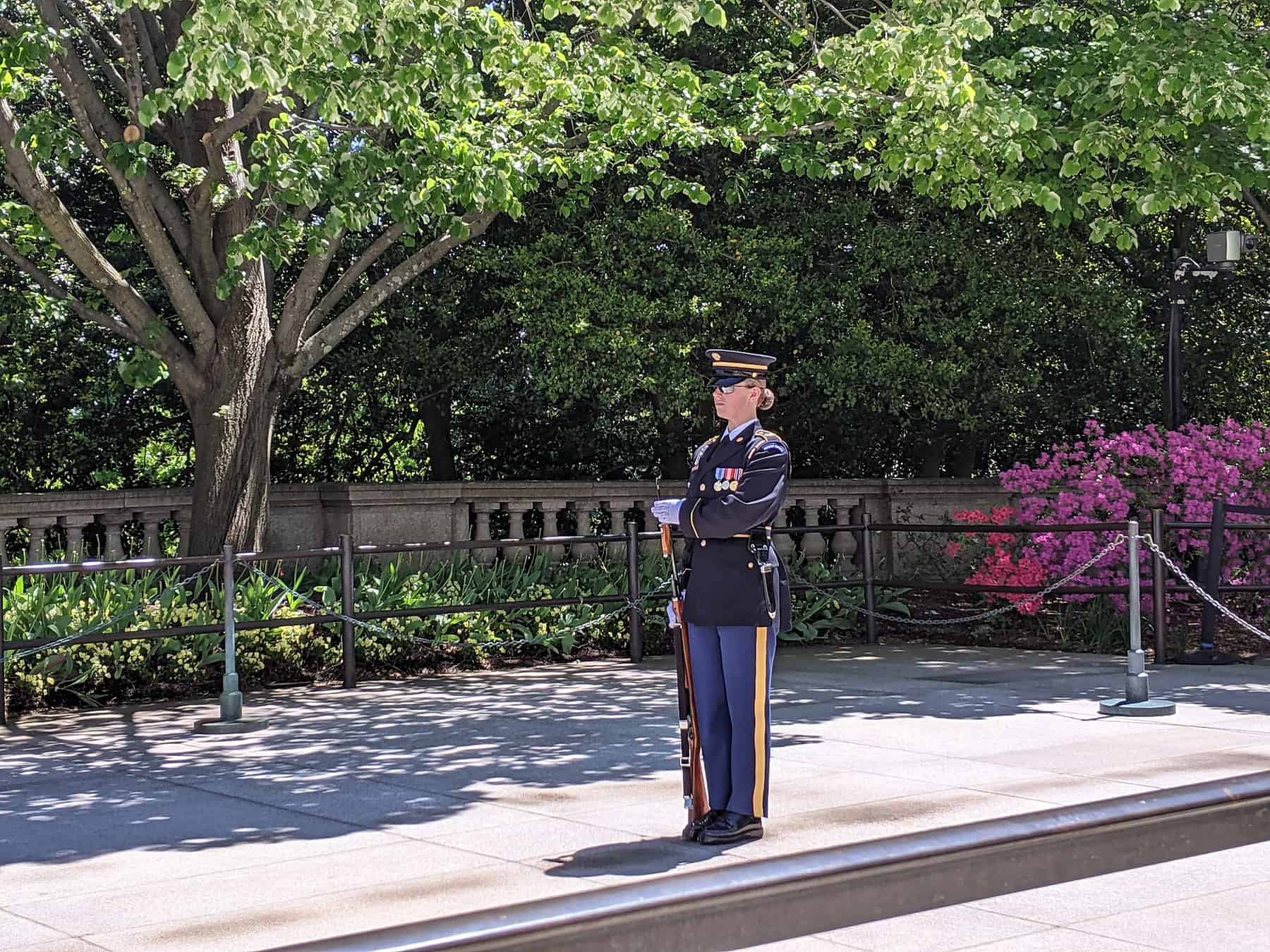
These are also flexible - a highly qualified candidate who is 5'9" will not be turned away.
There is no waist size requirement, other than meeting army regulations.
However, Tomb Guards do not aim to meet the minimum but to exceed it. Most guards are trim due to the nature of their work.
There used to be an unspoken rule if your uniform did not fit on the rack, you were too fat!
Once you apply, they look at your records. A past infraction does not immediately disqualify you from guarding the Tomb of the Unknown Soldier if you can prove you've learned from past mistakes.
A clean financial history and sound family life are preferred as well - no distractions, and you'll need support thanks to the hours worked and the demands of the job.
What is training like?
HARD! For the first two-week trial phase, all "newmen" are given basic instructions on uniform prep, the walk sequence, and behavioral assessments.
After this initial training, they are tested to see if they will continue. There is a very high success rate to get past the first round.
From here, the training is self-paced. The average to get through training is 7.5 - 8 months, though the fastest has been 4 months.
"Newmen" are given 12 hour duty days plus homework. They do not watch TV, acknowledge jokes told in the quarters, talk to the public, and do not talk to other guards unless spoken to (unless they have a question regarding training) - they are studying.
Newmen generally train on performance at night when the cemetery is closed to the public.
As one goes through the training, you are tested on three things on four separate occasions:
1. Uniform
2. Knowledge
3. Performance
Once you pass the first test, the requirements get more difficult. To become a fully qualified sentinel you must pass four rounds of the test.
Here are the requirements:
1. Uniform: You may have 2 minor infractions and no major infractions. A minor infraction is if any one item on your uniform is more than 1/64" out of place. There are more than 100 points on inspection. Think of it as taking a test at school, a 97 is a failing grade. There has NEVER been a 100 given.
2. Knowledge: Newmen are required to memorize a 17-page packet of information on the cemetery and write it out, including punctuation. In order to pass, you must have no more than 10 mistakes. If you miss a comma on each page, that is a double fail.
Fun Fact: Some of what they have to memorize are poems that reflect the solemnity and honor of the Tomb of the Unknown Soldiers.
3. Performance: With over 200 points of inspection, you may have no major infractions and only 2 minor. From foot placement on the mat to cadence. They aim for a 72 beats per minute cadence.
There is a 10% completion rate of passing the fourth and final test on these three components.
What happens if you fail?
Guards who fail a test can take it a second time. If you fail again and are released from training, you can come back later and start from the beginning.
If any guards are released from training due to disciplinary reasons, they are not welcome back.
What happens when you pass?
If you pass the 4th test, you become Fully Qualified and earn your Tomb Guard Identification Badge, the second rarest badge in the U.S. Army.
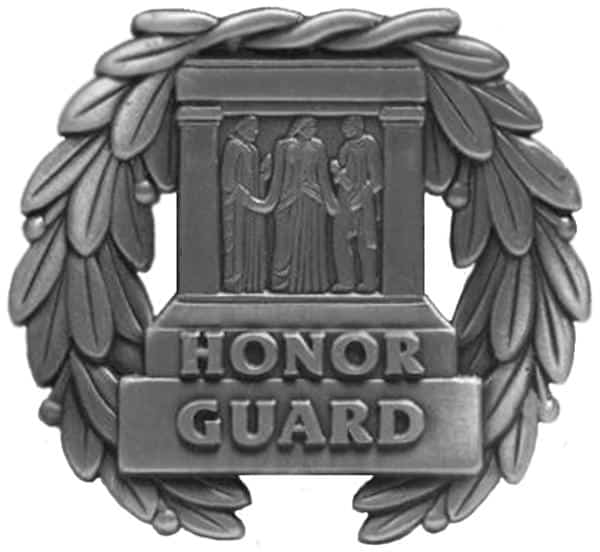
The sterling silver badge is worn on the right breast pocket of the uniform. This is the only way to tell a sentinel from a guard as you watch the ceremony. To the general public, it would be very difficult to tell if someone was still training.
No guard is allowed on the mat until it is confident that they will uphold the standards, usually, their first time out is about one month into training.
Even after you pass, you are not off the hook. Every single guard change is evaluated.
At any point, no matter how experienced you are as a sentinel, if the weapon touches the plaza outside the weapon inspection - you're released from being a tomb guard.
What is the Tomb Guard Identification Badge?
This is the second rarest badge to be earned in the US Military.
Once a guard has passed training to become a sentinel, you will see them wear this on their uniform on the right breast pocket.
It is an inverted laurel wreath with the words "Honor Guard" at the base.
Once a sentinel has served for at least 9 months, they may continue to wear this as part of their uniform.
What is the Sentinels Creed?
"My dedication to this sacred duty is total and whole-hearted. In the responsibility bestowed on me never will I falter. And with dignity and perseverance my standard will remain perfection. Through the years of diligence and praise and the discomfort of the elements, I will walk my tour in humble reverence to the best of my ability. It is he who commands the respect I protect, his bravery that made us so proud. Surrounded by well meaning crowds by day, alone in the thoughtful peace of night, this soldier will in honored glory rest under my eternal vigilance."

What is a Sentinel's uniform?
All guards are issued 1 uniform and are responsible for maintaining it. It is a standard uniform however this one is made of wool instead of standard-issue polyester.
Most guards end up owning 3 sets. One regular day uniform, one for rain, and one they are working on.
In some cases due to weather elements and fading, a uniform may need to be replaced after only 9 days!

Guards do not wear rank on their uniform as they cannot outrank the unknown soldiers, and we don't know what rank they were.
All the unknown soldiers have been awarded the Medal of Honor, the highest honor one can receive, so tomb guards can wear any medals they have earned as they will not out medal the unknowns.
The issued uniform comes with shoes with rubber soles and sides. If you see them on the mat, it looks like patent leather but it's just spit-shined with kiwi shoe polish.
In fact, very little of their uniform is patent leather or plastic, despite what it looks like.
The holster that the NCOs have and the scabbard that the guards wear are all standard-issue green leather with faded silver fittings.
Each guard sands with fine sandpaper bonds the holes, and spray paints the leather black, polishing it to a smooth, shiny surface.
The fittings are polished to a bright silver. This is all done by hand by each individual man.
How long does it take to prepare the uniform?
For a newman, it might be half a day (as in 12 hours). For a fully qualified sentinel that is practiced, only 5-6 hours.
What happens in bad weather?
They get wet. The tomb is always guarded and the guards are not protected from discomfort of the elements.
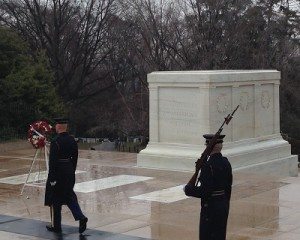
If it is too cold or raining, the guards change to black leather gloves from white gloves and the weapons inspection does not take place.
Other than that it is walking the mat as normal.
There is a small shelter on the plaza in cases of severe weather where the sentinel will remain at attention.
What about at night?
The tomb is guarded but they are not restricted to walking the mat. They are on roaming duty on the plaza.
What is the shift rotation?
Day 1: 24 hours on
Day 2: 24 hours off - this is not off duty. This is where they continue to study, prepare, and shine those shoes.
Day 3: 24 hours on
Day 4: 24 hours off
Day 5: 24 hours on
Day 6: 24 hours off
Day 7: PT as a group in the morning, rest of the day off
Day 8: The only true day off where they are not coming from a 24-hour shift.
Day 9: Training Day
Rinse and repeat for 1-1.5 years.
All guards are responsible for their own meals and there is a kitchen in the quarters underneath the memorial amphitheater.
These are not true barracks but are only considered living quarters due to the hours worked. There are 3 cots for naps - though there is very little time for that.
How is a guard selected to walk the mat?
For Fully Qualified Sentinels - they sign up for shifts.
For newmen, they must be prepared at all times to go out on the next change. A few minutes before the guard change, they are quizzed and must earn their spot on the mat.
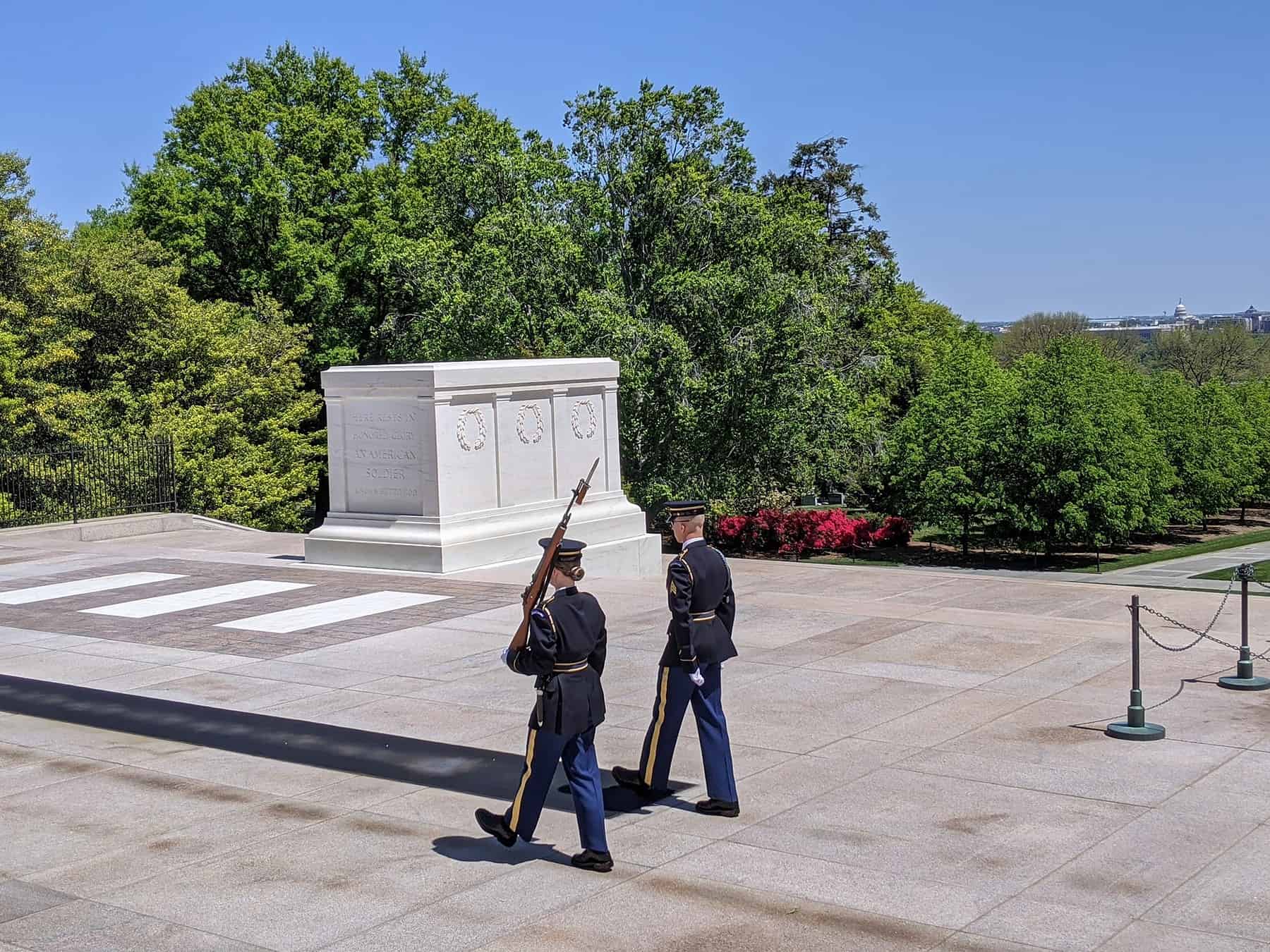
What is with the noise the shoes make when clicking their feet together?
Their shoes have additional plates on the sides. The interior soles jut out about .5" from the regular shoe surface and are called cheaters.
The original guard was the Calvary, who wore spurs on their shoes making a sound when they brought their feet together.
To honor that heritage, the 3rd regiment Tomb Guards added the cheaters to replicate the sound.
They are also used as nonverbal cues, in addition to foot scrapes to note where a guard is in his walk.
What happens after their 1-1.5 years as a Sentinel?
Guards usually only perform this duty for 1-1.5 years. It is not meant to be a lifetime appointment but rather an honor to serve and then take what you have learned and apply it to new fields and arenas.
Men and women who become sentinels often become successful businessmen, serve as Army Rangers, in Delta Force, and other elite units.
Once they've earned your badge, they keep it for the rest of their lives. Unless you do something to dishonor the tomb or the Army. It is the only badge in the army that the standards for revocation are not related to regulations but rather personal conduct.
Felonies, DUIs, are all reasons that they have been revoked. The badge is taken and your name is stricken from the record.
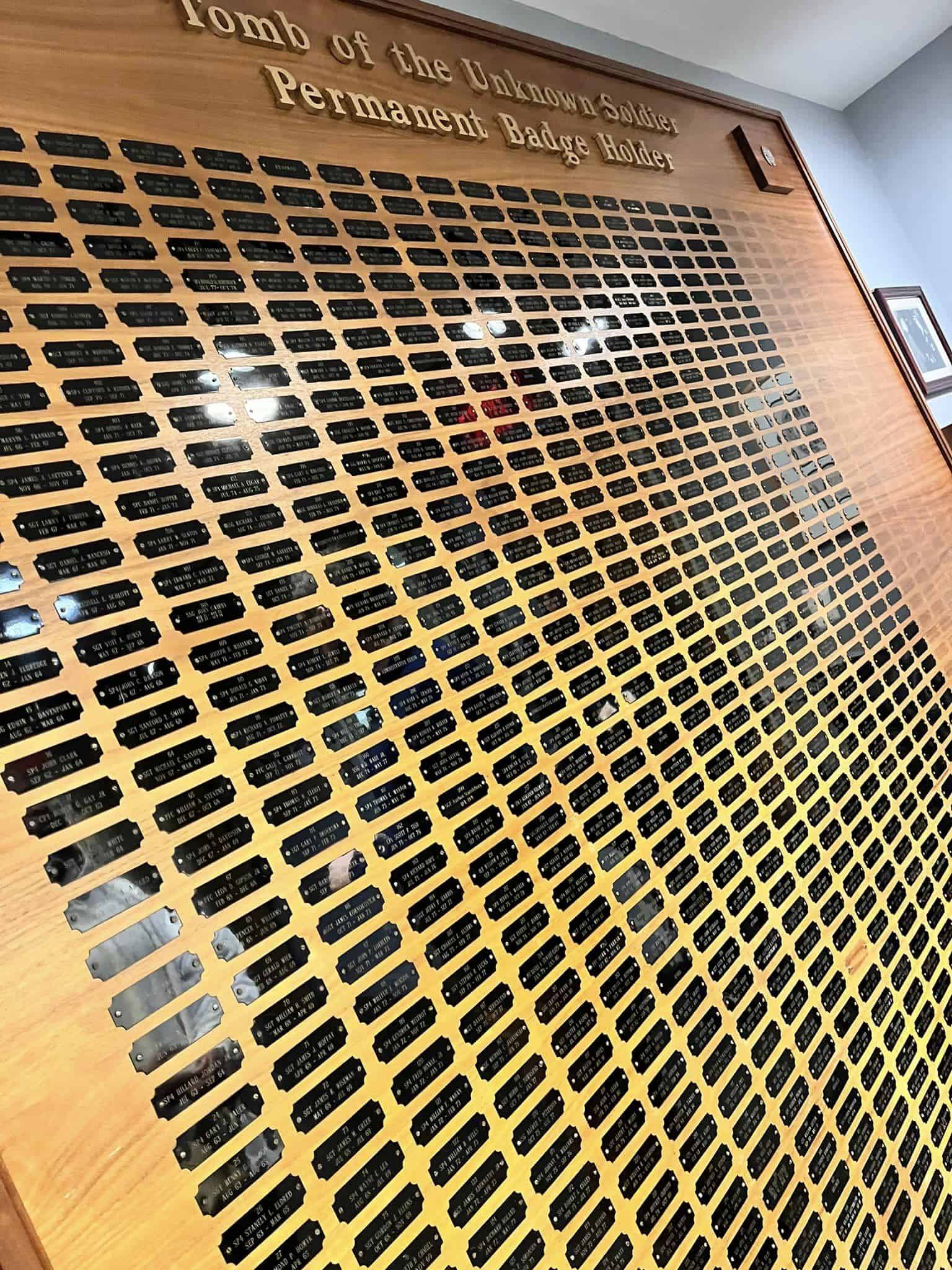
What should all guests know?
We can't tell you all their secrets! Take our Arlington National Cemetery Tour to find out more about the Tomb Sentinels and watch the Changing of the Guard ceremony for yourself!







